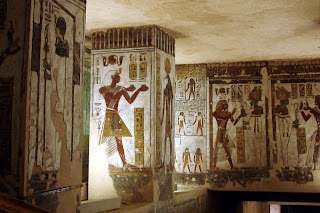The BBC and other news outlets are reporting this morning that recent CT scans on the mummy of Pharaoh Ramses III reveal a large and deep cut across his throat that was probably fatal. The Pharaoh apparently was assassinated. Until now, the fate of the Pharaoh Ramses III was largely unknown. All of the surviving ancient records describe an attempted coup in 1155 BCE by one of his 2 wives, Tiye and by one of his sons, Pentaweret. The records agree that the coup failed. Prince Pentaweret was captured and committed suicide. The assassination now appears to have succeeded.
The mummy of Pharaoh Ramses III; the linen around his neck cannot be removed because of preservation issues. Until now, it hid the fatal injury in his neck.
The mummy of Ramses III was among the New Kingdom royal mummies discovered all together in a single tomb in the cliffs of Deir El Bahri. Priests from a later dynasty removed most of the royal mummies from their tombs in the Valley of the Kings in order to protect them from looters (perhaps from mobs of looters descending on the Valley during a time of political and social disintegration). When the cache was discovered in 1875, another mummy was discovered near Ramses III's mummy of an unknown man in a plain unadorned coffin, the Unknown Man E, better known as the "Screaming Mummy."
Unknown Mummy E, "The Screaming Mummy"
His mummification had been very hastily done with no evisceration. The embalmers wrapped his body in a goat skin (considered very unclean by the ancient Egyptians) before putting it into the unpainted coffin with no inscriptions. The hands and the legs of the body were bound with leather thongs. He was very young, only about 18 years old. The circumstances of the burial and the striking expression on the withered face gave rise to all kinds of speculation that he had been buried alive.
Recent forensic DNA tests on this mummy indicate that he was from the royal family, and directly related to Ramses III. Scholars now think that this is the mummy of Prince Pentaweret who led the coup attempt. This would explain the shabby treatment of this mummy by the embalmers.
Ramses III was the last great king of the New Kingdom period of Egyptian history. Even before his death, Egypt began to suffer economic decline and foreign predation. Most of his reign was consumed in warfare, repelling invasions by the neighboring Libyans and by the Sea Peoples who may have been seafaring Greeks enduring their own dark age in the wake of the Dorian Invasions. Though ultimately victorious for Egypt, these wars were hard fought and very costly in terms or lives and treasure.
Pharaoh Ramses III's mortuary temple at Medinet Habu near Luxor is the last great monument from New Kingdom Egypt. The king was buried in a secret tomb in the Valley of the Kings, but in this massive temple on the west bank of the Nile, resident priests perpetuated his cult for centuries.
The granite sarcophagus of Ramses III in the Louvre
The mortuary temple of Ramses III at Medinet Habu
The entrance to the temple of Ramses III
A relief sculpture from the temple showing the Pharaoh killing captured enemy soldiers
EXTRA:
The mummy of Ramses III was the inspiration for the extraordinary makeup for Boris Karloff in the 1932 movie The Mummy.
EXTRA:
Paintings from the tomb of Ramses III in the Valley of the Kings:










1 comment:
I've heard some info about Ramses was possibly coming, but this is fascinating!
Post a Comment